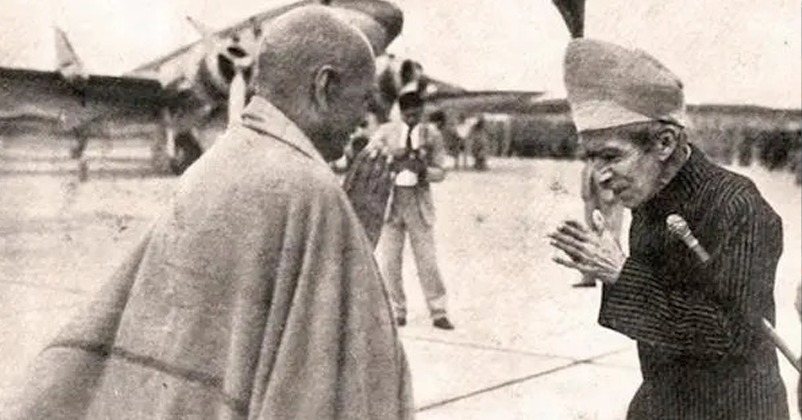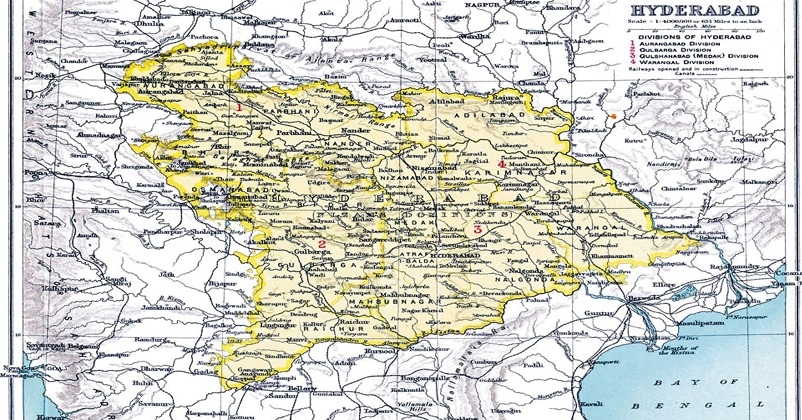17 September 1948: Hyderabad Accession Day
17-Sep-2023

Although Bharat became independent on 15th August 1947 but simultaneously 562 princely states within Bharat also got the choice to accede with either Bharat or Pakistan. Home Minister Sardar Vallabhbhai Jhaverbhai Patel and his trusted secretary and famous ICS officer VP Menon were entrusted with the responsibility of uniting the provinces into one nation.With efficient leadership and a brilliant strategy, Sardar Patel and VP Menon made the impossible possible, and within a year 562 princely states were ready to merge with Bharat.
But the areas which were still not merged with Bharat were principally Jammu and Kashmir, Junagadh and Hyderabad. Among them, Hyderabad was not only the largest princely state, but its total geographical area was also way larger than the United Kingdom. The princely state of Hyderabad included many areas of states like present-day Maharashtra, Telangana, Andhra Pradesh, Karnataka, and Chhattisgarh. Hyderabad was then ruled by Nizam Usman Ali Khan, the seventh ruler of the Nizam Asaf Jahi dynasty.
However, he was a mere puppet, as real power was in the hands of Kasim Rizvi, one of the advisors to the Nizam and a powerful leader what is known today as the Majlis-e-IttehadulMuslimeen. Kasim was leading a private army of his own followers, known as the Razakars. According to sources the number of Razakars ranged between 20000 and 2 lakhs. According to these Razakars, either Hyderabad should have been an independent state, where Sharia law would’ve been in force, or it should have been merged with Pakistan.
Even though Hyderabad was ruled by radical Razakars, the people there not only opposed their rule but were also willing to merge with Bharat at any cost. Also, as Pakistan was about 1500 km away from Hyderabad region, so it wasn’t logical to talk about their inclusion.
The Razakars resorted to the path of terror. They targeted non-Muslims and not only innocent people were sacrificed, but also the women and girls were mistreated, on the same lines as during the Direct-Action violence in Bengal or during the Partition of undivided Punjab. The Nizam allowed all these atrocities.
It was decided that Hyderabad should be asked to sign a standstill agreement, in which the Bharatiya Army would be stationed outside the borders of Hyderabad and Hyderabad would treat its citizens fairly. But the Nizam refused to accept the proposal due to the fierce demonstrations and violence of Kasim Rizvi’s Razakars. The standstill without troop stationing couldn’t’ sustain as atrocities on non-muslim populations were rising day by day and finally Sardar Patel had to resort to the use of force. Military operations under Operation Polo began on 13 September 1948. The Bharatiya army forced the Razakars to flee the battlefield. Finally, at 5 pm on 17 September 1948, the Nizam announced a ceasefire. Major General Jayanto Nath Chaudhuri accepted the surrender of Hyderabad Chief of Army Staff, Major General Syed Ahmed Al Edroos and Hyderabad was officially merged with Bharat.
Key Points
The State of Hyderabad was founded by, the fifth Qutb Shahi Sultan of Golconda, Mohammad Quli (r.1580-1612) on the banks of the Musi River in 1591 who built a city as ‘a replica of Islamic heaven’. On 21 September 1687, the Golconda Sultanate came under the rule of the Mughal emperor Aurangzeb and MirQamruudin Chin Qilich Khan the son of Aurangzeb’s General Ghaziuddin Khan Feroz Jang became the ruler of the state who claimed his ancestry to first Khalifa, Abu Bakr.
Hyderabad was a last remnant of Mughal empire which had a pivotal geopolitical position as it was surrounded by central provinces in north, Bomaby in west and Madras in east and south.
It was a premier state with approx. 16 million population, Rs 26 crore annual revenue and 82000 square miles area and having its own currency.
British administration never treated Hyderabad differently in comparison to other states despite its premier position which the Nizam always aspired for.

The 85% of population of the state were Hindus but they were denied the civil, police and army positions, these were close preserves of the Muslims.Even in 132 membered Legislative assembly set up by Nizam, the Muslims were in Majority.
After the announcement of British Government’s 3rd June plan of formation of two states Bharat and Pakistan, the Nizam of Hyderabad Osman Ali Khan, Asaf Jah VII issued a firmaan , not to send any representative to constituent assemblies of Bharatand Pakistan and become Independent sovereign state.
He sent a delegation headed by the Nawab of Chhatari to meet Lord Mountbatten to discuss the demand of Nizam to retrocessBerar to Nizam, grant of Dominion status to Hyderabad.
The Nizam’s both demands were technically declined as Mountbatten opined that Berar was practically integrated with central provinces, therefore any changes in status quo can be changed with the consent of the people of the area. Similarly, Dominion status for Hyderabad was also rejected as Mountbatten said firmly stated that His Majesty’s Government will only accept through either of the two new dominions.
These proposals were unacceptable and delegation returned to Hyderabad.
The last viceroy of Bharat and the first governor general after independence Lord Mountbatten was hopeful for Hyderabad’s accession with Bharat and he pleaded that some extra time should be given to Nizam to educate the 15% minority which was holding the most of top position.
On 8th August Nizam again wrote to Mountbatten to not accede with Bharat but enter to an agreement with Bharat with conditions of almost autonomy as independent sovereign state, specially the demand of privilege of not to align with Bharat in case of any war with Pakistan.
After several round of negotiations, in November 1947, Hyderabad signed a standstill agreement with the dominion of Bharat, continuing all previous arrangements except for the stationing of Bharatiya troops in the state. However, with the rise of militant razakars with whose support, Nizam wanted to establish independent Islamic state, the life of majority Hindus became hell. In order to curve the menace of militant Razakars and Nizam, it became necessary for Bharat to take punitiveaction against state of Hyderabad in September 1948 leading to surrender of Nizam and sign the final accession with Bharat.
Nizam, Muslim Majlis, oppressor Khasim Razvi all tried their best to prevent Hyderabad’s merger into Bharatiya Union and cheated the people. Nizam declared that Hindus and Muslimsare as dear to him like his two eyes; he cleverly fooled the people by saying, Hindus would be upset if Hyderabad merged with Pakistan and Muslims would not like, if it merged with Bharat; hence in these circumstances, it would be better if Hyderabad remained independent. He hid his ambitions and religious fanaticism and issued a decree declaring Hyderabad as independent. But the reality was very different. Hindus who constituted the majority population in Hyderabad wished to merge their region in the non-religious independent Bharat and wanted a responsible democratic government to be established. Hyderabad state congress party was struggling to achieve this aim. And the nizam was trying to hide the reality and suppress people’s aspirations. He nurtured the religious organization `ittehadul musalmeen’ to support him in this venture.
Role of Opposition Political Parties
A number of political organizations began to be founded with goals of bettering the economic and social plight of the majority Hindu community in the state. The Andhra Mahasabha was formed in 1936. This organisation became the cover organisation of the banned Communist Party of Bharat(CPI) who was the vanguard of the peasant Telangana Armed Struggle.
While the Arya Samaj was established as early as 1892, in 1938 it came under attack by the Nizam’s government as it issued orders that the Arya Samaj could not set up kunds –fireplaces for prayers – without the express permission of the government19. Following this policy, the famous 1938 Satyagraha was launched that saw an increasing polarization between the Hindu and Muslim communities in the state.
The Hyderabad State Congress was founded in September 1938 with the goal of responsible government under the aegis of the Nizam and the Asaf Jahi dynasty.”
The object of the Hyderabad State Congress is attainment by the people of Responsible Government under the aegis of H.E.H. the Nizam and the Asaf Jahi dynasty. This object is to be achieved by all peaceful and legitimate means and by promoting national unity, fostering public spirit and developing and organizing the intellectual, moral, economic, and industrial resources of the country.As
...